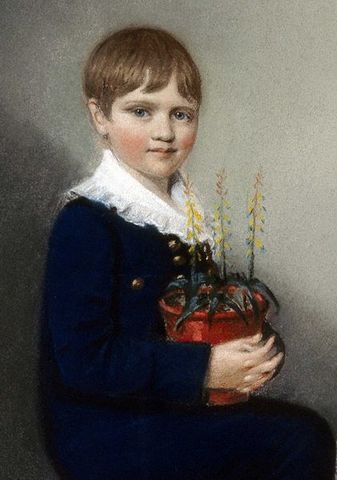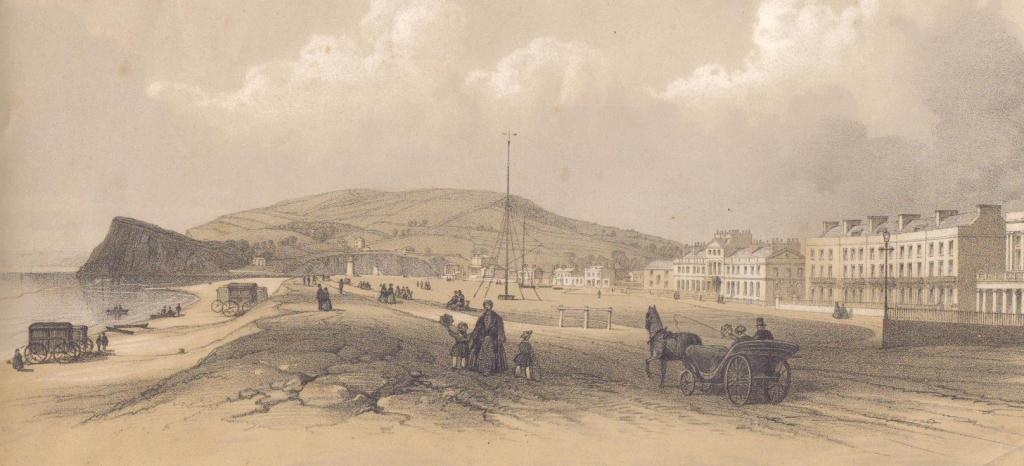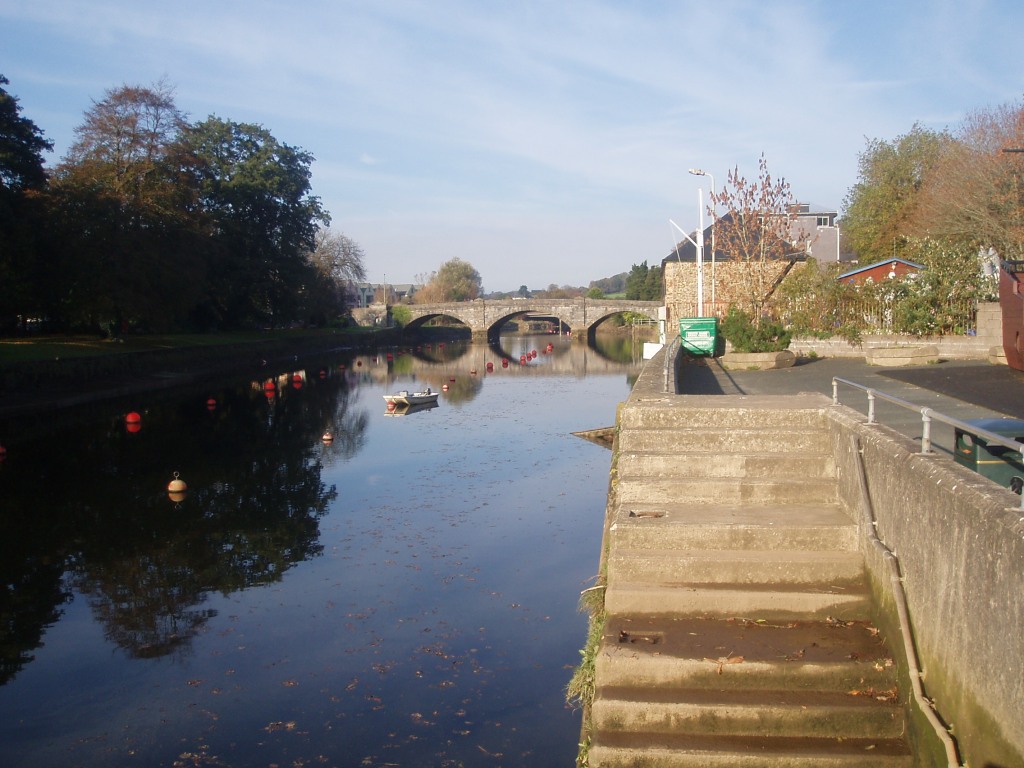Over the years I have written a series of blog posts about Charles Babbage, but I have never written about who he was and where he came from. What follows is a brief biographical sketch of the boy, the student and the young man finding his way in life.
The Babbage family had its roots in the idyllic market town of Totnes, situated at the head of the estuary of the River Dart in Devon. Charles’ great grandfather, a John Babbage, is first recorded in 1719 taking out a lease on a house in Totnes, the neighbouring house to the one he already owned. He was, it seems, a shopkeeper and a goldsmith. In 1747, a Mrs Babbage, John’s widow, is listed in the tax assessment as owning four houses, and her son Benjamin, Charles’ grandfather, another. The family was obviously wealthy.
 100vw, 1024px”></a><figcaption class=) River Dart at Totnes Source: Wikimedia Commons
River Dart at Totnes Source: Wikimedia CommonsBenjamin, also a goldsmith, married Mistress Margaret Laver in 1740. They had four children who lived to maturity, John (b. 1741), Anne (b. 1747), Margaret (b. 1749), and Charles’ father, another Benjamin (b. 1753). Grandfather Benjamin died intestate in 1761, which meant that John, as the eldest son, inherited everything, and the younger Benjamin had, so to speak, to start from scratch, but it can be assumed that he received assistance from his wealthy relatives. Father Benjamin possibly followed the family profession of goldsmith but became a banker. The transition from goldsmith to banker was fairly common. Benjamin probably didn’t open a bank in Totnes but functioned purely as a private banker.
About 1790, Benjamin, now a wealthy man, married Elizabeth Plumleigh Teape. The Teapes were a high-ranking Totnes family. In 1791, Benjamin moved to London, buying a house in what is now Southwark, Charles was born in this house on 26 December 1791. In 1794, a second son, christened Henry, was born but he died in infancy. In 1796, a third son, also christened Henry, was born but he too died whilst still very young. Charles’ sister Mary Anne, who would outlive him, was born in 1798.

Charles Babbage as a child
At the end of the century Benjamin became a partner in the newly established Praed Bank of London, The Praeds, like Benjamin also from Devon, already owned banks in Turo and Exeter. At the same time Benjamin moved his family to a new house in Adelphi, a district of the City of Westminster. Circa 1803, Benjamin retired from his partnership and returned with his family to Totnes and about five years later bought a house in Teignmouth, a Devonshire fishing port on the estuary of the River Teign, about twenty-five kilometres north-east of Totnes. This was to be Charles’ home until he got married and set up his own home.

Charles’ education was a very mixed affair. As a child he suffered a severe fever, and having already lost two sons to illness, his parent sent him away to Devon to convalesce, to a school in Alphington by Exeter. When he was healthy again, he attended a small school in Enfield, then a small village near London. The school mater, Stephen Freeman, was an amateur astronomer and it appears that here that Charles first developed his own interest in mathematics and astronomy. He even talked a fellow pupil to getting up at tree o’clock in the morning to study algebra until five! Other pupils became involved and eventually being caught and Charles received a dressing down. Following Enfield, Charles was sent to a private tutor near Cambridge for a few years, where he appears to have learnt very little. Next, he was brough home to Devon and Totnes Grammas School, where an Oxford tutor brought his classics up to speed for university entrance, going up to Trinity College Cambridge in 1810.
Having caught the mathematics bug early, Charles had taught himself mathematics from the best books available and he found the antiquated Cambridge mathematical tripos primitive and trivial. He soon discovered that he was mathematical superior to his college tutors. Here we see the Charles Babbage that was to come in action. Whenever Babbage saw a problem in science, technology, or economics he immediately began to work on a solution. Here the problem was the, in his opinion, miserable quality of the Cambridge mathematical curriculum, so together with his fellow students, the future astronomer, John Herschel (1792–1871), the future co-founder of modern abstract algebra, George Peacock (1791–1885), and others, he founded the Analytical Society dedicated to reforming, modernising, and bringing up to continental standards, English nineteenth century mathematics. The Society was famous for its aim to promote the principles of d-ism as opposed to the dot-age of the university. I’ve written a blog post about it here.
Charles was very open, sociable and that wonderful English word, clubable. Armed with an allowance of £300 per annum, from his father, which made him by student standards relatively wealthy, he threw himself into the extra-curricular life of the university founding societies and joining others. He even maintained a sailing boat on the Cam taking other students on weeklong excursion into the Cambridgeshire fens. Of particular interest was his association with Herschel, William Whewell (1794–1866), and Richard Jones (1790–1855), which you can read about in Laura J Snyder’s excellent The Philosophical Breakfast Club, Broadway Books, NY, 2011.
 School; Charles Babbage (1792-1871) ; National Trust, Dudmaston; http://www.artuk.org/artworks/charles-babbage-17921871-132467</p>
<p> ” data-medium-file=”https://wolfscientific.com/wp-content/uploads/2022/12/christmas-trilogy-2022-part-2-a-portrait-of-the-mathematician-as-a-young-man-17.jpg” data-large-file=”https://wolfscientific.com/wp-content/uploads/2022/12/christmas-trilogy-2022-part-2-a-portrait-of-the-mathematician-as-a-young-man-19.jpg?w=500″ src=”https://wolfscientific.com/wp-content/uploads/2022/12/christmas-trilogy-2022-part-2-a-portrait-of-the-mathematician-as-a-young-man-3.jpg” alt class=”wp-image-9996″ srcset=”https://wolfscientific.com/wp-content/uploads/2022/12/christmas-trilogy-2022-part-2-a-portrait-of-the-mathematician-as-a-young-man-3.jpg 850w, https://wolfscientific.com/wp-content/uploads/2022/12/christmas-trilogy-2022-part-2-a-portrait-of-the-mathematician-as-a-young-man-16.jpg 125w, https://wolfscientific.com/wp-content/uploads/2022/12/christmas-trilogy-2022-part-2-a-portrait-of-the-mathematician-as-a-young-man-17.jpg 249w, https://wolfscientific.com/wp-content/uploads/2022/12/christmas-trilogy-2022-part-2-a-portrait-of-the-mathematician-as-a-young-man-18.jpg 768w, https://wolfscientific.com/wp-content/uploads/2022/12/christmas-trilogy-2022-part-2-a-portrait-of-the-mathematician-as-a-young-man-19.jpg 996w” sizes=”(max-width: 850px) 100vw, 850px”></a><figcaption class=) English School; Charles Babbage (1792-1871) ; National Trust, Dudmaston; http://www.artuk.org/artworks/charles-babbage-17921871-132467 Portrait from about 1820
English School; Charles Babbage (1792-1871) ; National Trust, Dudmaston; http://www.artuk.org/artworks/charles-babbage-17921871-132467 Portrait from about 1820Babbage went down from Cambridge in 1814, with a simple degree without examination and did not applyfor a scholarship, a rather strange move given his undeniable abilities. What did he intend to do with his life?
Whilst still a student Charles had met, fallen in love with and become engaged to Georgiana Whitmore (1792–1827), sister of the landowner and politician William Wolryche-Whitmore (1787–1885). They got married 2 July 1814, much to the chagrin of Charles’ father Benjamin. He had nothing personal against Georgiana but considered his son foolhardy for marrying before he had established himself in life, in fact, before he even had employment.
 100vw, 294px”></a><figcaption class=) Georgiana Babbage, wife of Charles Babbage, early 19th century. Source
Georgiana Babbage, wife of Charles Babbage, early 19th century. SourceThe young couple had Charles’ £300 pa, which was bestowed for life, and the interest from Georgiana’s marriage settlement, which amounted to £150 pa. This enabled them to live comfortably if not extravagantly and would prove to be their main source of income for the next thirteen years. It increased somewhat when Georgiana received a small inheritance. They had eight children of which only four survived childhood.
Charles was basically now a philosopher for hire, and he found it difficult to find anyone to hire him. Around 1820 he started on his plans for the Difference Engine, which formed the core of his interests. He travelled quite a lot, oft together with John Herschel, became friends with many of the leading continental scientist and mathematicians. He applied for a couple of chairs of mathematics but failed to get appointed. He dabbled with life assurance, a popular method of earning a living for mathematicians, but in the end decided it was not his metier.
Everything would change dramatically in Charles’ life in 1827. On 27 February 1827 Benjamin Babbage, who had been an invalid for many years, died. Charles’ inherited the majority of his estate, a total in property and money of about £100,000 making him a very wealthy man and ending the need to find gainful employment and setting Charles and Georgiana up for the rest of their lives. Unfortunately, Georgiana did not enjoy her new financial status very long, as she died in August of the same year.
Charles was totally devastated and having parcelled off his children to various relatives he left England with the intention of travelling overland to the Far East. He meandered through Europe renewing friendships and making new ones. Unfortunately, the rout to the east was blocked by war and so he extended his wanderings through Europe visiting universities, research institutes and factories, giving demonstrations of his own knowledge and absorbing vast amounts of new knowledge.
He finally returned to England late in 1828, a wealthy philosopher full of ideas about how to shape the future, which he now set out to attempt to do.
